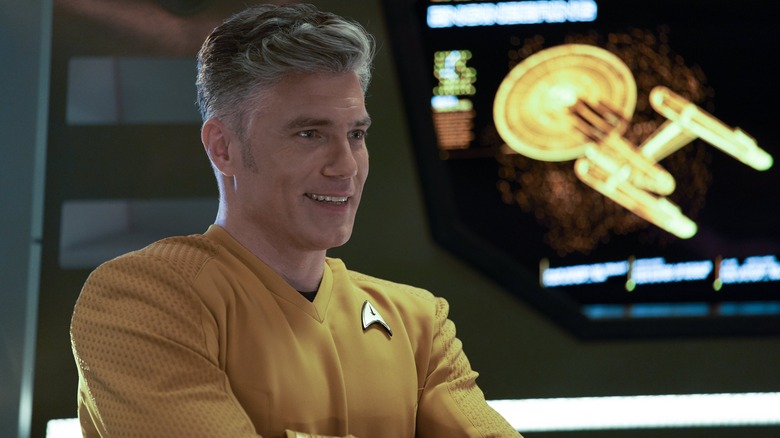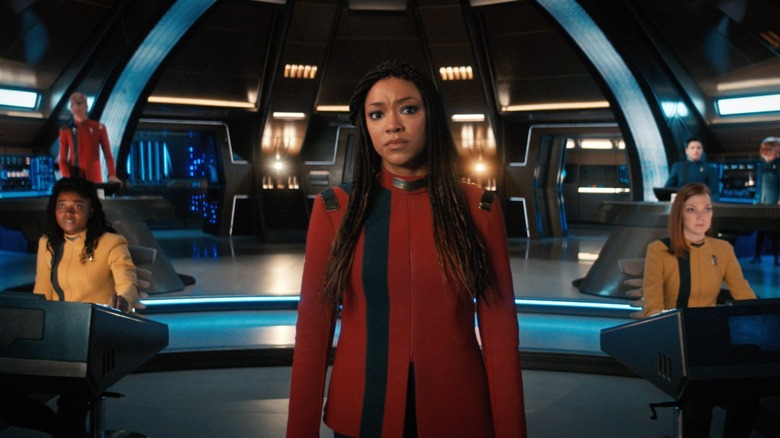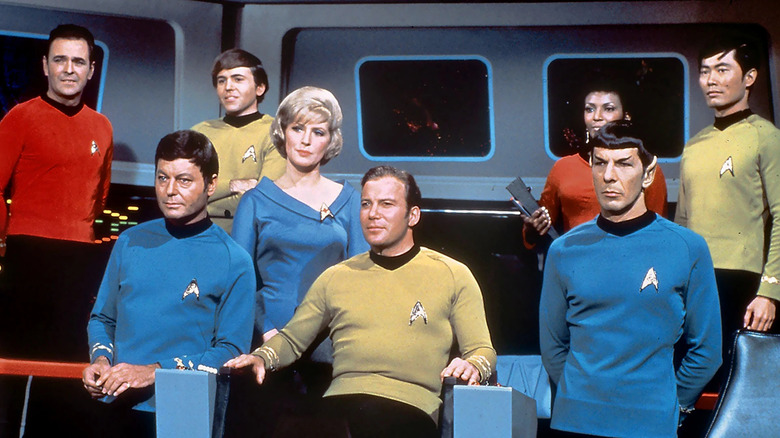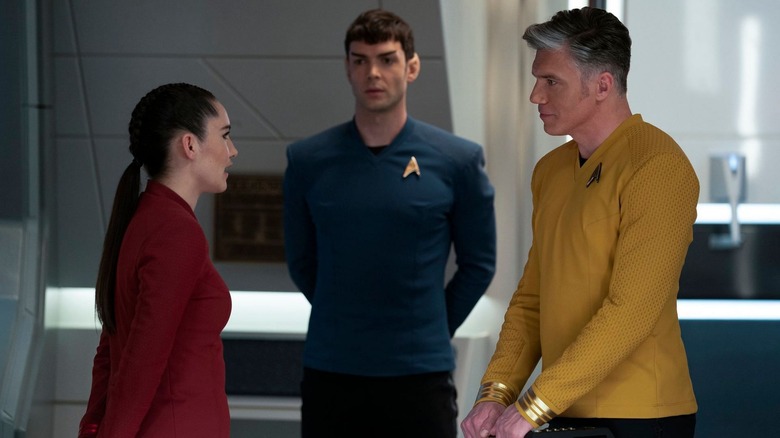Star Trek: Strange New Worlds Has Already Fixed A Major Discovery Problem
We stand in the midst of a "Star Trek" renaissance. There are currently five "Star Trek" shows currently airing and another few still in production. There's a different flavor of "Star Trek" for everyone, whether that's "Star Trek: Discovery," "Star Trek: Picard," "Star Trek: Lower Decks," "Star Trek: Prodigy," and now "Star Trek: Strange New Worlds."
With its pilot episode behind it, "Strange New Worlds" is getting a lot of praise from the "Star Trek" fandom. Viewers of "Discovery" were already excited for Anson Mount's take on Christopher Pike, the Captain of the Enterprise that preceded the famous James T. Kirk. Alongside Pike come new iterations of Number One and Spock from "The Cage," the pilot episode of the original "Star Trek."
"Strange New Worlds" succeeds by looking back into the history of "Star Trek" — not in a narrative sense, but in the roots of the series' composition. "Strange New Worlds" works so well because it remembers the fun of episodic television.
Step by tiny step
While the previous "Star Trek" shows were episodic affairs, the flagship of the newer series, "Star Trek: Discovery," was built for the streaming era. The first two seasons of "Discovery" tell single, overarching storylines across their episodes. The seasons can be watched episode by episode, but overall they're crafted to be viewed as one big story. Essentially, they're binge-worthy television.
The difference is older "Star Trek" shows were built for syndication. The shows were sold to local affiliate networks, where they'd not necessarily be watched by viewers on a consistent basis. "Star Trek" and "Star Trek: The Next Generation" were made so that a viewer could watch any episode, in any order. Characters and the status quo might change over the course of a season or multiple seasons, but not enough to prevent a new viewer from quickly picking up a show's general premise.
For most of television history shows were built to be episodic, until the rise of longform prestige television shows like "The Sopranos," "The Wire," and "Breaking Bad." These shows highlighted one of the problems of episodic television: the inability to tell a longer, more cohesive story. If every episode has to be a complete story on its own, then you can't build toward a climactic crescendo. Episodic shows have to take baby steps forward, usually saving big changes for season finales.
"Star Trek: Deep Space Nine" is probably one of the earlier hallmarks of this shift in storytelling. While "Deep Space Nine" had standalone episodes, the series started telling longer storylines over many episodes in later seasons. That's part of what separated the show from its "Star Trek" peers, but also why it probably wasn't as popular as its more-episodic predecessor "Star Trek: The Next Generation." "Deep Space Nine" gained a lot of fans when the streaming era began and viewers could binge the entire thing from beginning to end.
Replicating some comfort food
There's another benefit to episodic television, however: It's comfortable and familiar. Episodic shows are built around a strong premise and a charismatic cast. Every week, you get to come and see all these beautiful, charming people butt their heads against a new problem. The character arcs exist, but they're broad and slow.
How will Detective Olivia Benson handle this week's horrific case on "Law & Order: Special Victims Unit?" What absolute nonsense will the "It's Always Sunny in Philadelphia" gang get up to in the latest episode? Who will Homer Simpson and the rest of his family meet this week? Given that the shows I mentioned here are at twenty-three, fifteen, and thirty-three seasons respectively, you can see the power of episodic television.
That power is where "Star Trek" used to the thrive and where "Strange New Worlds" differentiates itself from its peers.
To boldly go back to the status quo
From its first episode, "Strange New Worlds" quickly defines its cast and its overall premise. Even if you've never watched the original "Star Trek" or "Discovery," you get a strong feeling of who Pike, Una, Spock, La'an, Uhura, Ortegas, and the rest are. Their broad personalities shine through. And by the end of the episode, you have the premise: the crew of the Enterprise, exploring the galaxy and solving problems.
In contrast, it took until the third season for "Discovery" to really get a strong overall thrust for the entire show, rather than just a single season. Likewise, the show also took that long to really explore the other members of the bridge crew. Burnham, Tilly, and Stamets got shine in the first two seasons, but characters like Detmer and Owosekun are still recurring characters and deserve more exploration. That's where "Discovery" falters the most. I don't dislike the show, but it doesn't always offer what I want from "Star Trek."
Yes, the act of "tuning in" is different in 2022. Yes, long-form storytelling the heart of great drama, which is why shows like "Better Call Saul" and "Succession" continue to impress. But sometimes we don't want deep, heady drama, we want fun and adventure. We crave the enjoyable whodunits of "Columbo" or "Monk." We thrill to the ongoing adventures of "Stargate SG-1" or the scientific discoveries of "Eureka."
Sometimes we just want to come back each week and watch a crew of talented, fun people solve some science problem or give a solemn speech to the alien of the week. That's where "Star Trek: Strange New Worlds" lives. In the promise of familiarity and comfort. In the moment where you come into a room and ask someone, "Whatcha watching?" before sitting down to enjoying it alongside them, because you can. When the barrier to entry is a few minutes, rather than hours of television. Hopefully, that's where "Strange New Worlds" can thrive for a long, long time.
New episodes of "Strange New Worlds" release Thursdays at 3:00 a.m. ET/12:00 a.m. PT on Paramount+.



